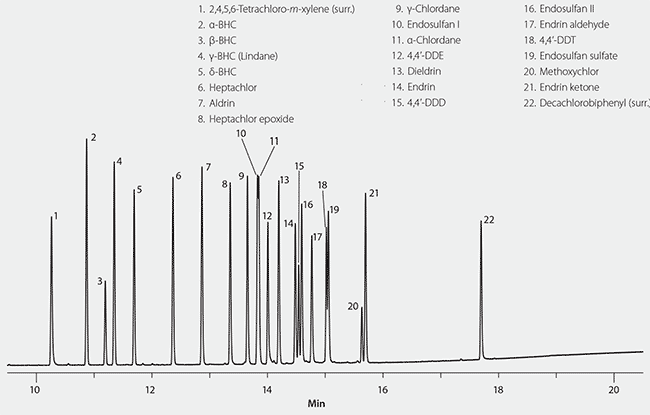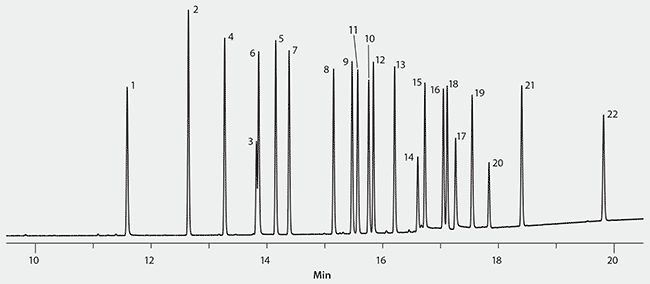Dual-Column GC Analysis of Organochlorine Pesticides on SLB®-5ms and SLB®-35ms
Lynne Perez-Blanco, Katherine K Stenerson, Michael D Buchanan
Reporter US Volume 33.4
The analysis of low levels of 20 organochlorine pesticides and 2 surrogate compounds by gas chromatography-electron capture detector (GC-ECD) is routinely performed by analysts in environmental laboratories. Methods require the analysis of each sample extract on two columns with orthogonal selectivities for confirmation of identifications.
An ECD is highly sensitive, capable of detecting analytes at picogram levels. Its highly sensitive nature, in combination with the low detection limit requirements of promulgated methods (i.e. US EPA Method 608, 8081, and OLM04.2 PEST), make it necessary to use GC columns with low bleed. In addition, the susceptibility of several analytes to degradation and adsorption make inertness another extremely important characteristic when choosing analytical columns.
Dual Column Analysis
This application requires two analytical columns for the analysis of samples. The first, often referred to as the “primary” column, is used to determine, by retention time comparison with a standard, if any of the target analytes could be present in the sample. If peaks are found within an analyte’s retention time window on the primary column, the presence of the analyte must be “confirmed” on a secondary or “confirmation” column with a different selectivity in order to be considered positive. Our SLB®ms column family is designed for GC and GC-MS analysts who require low bleed, inert, durable, and consistent capillary GC columns. Their use can help achieve low detection limits, easy mass spectral identification, less instrument downtime, good resolution, short analysis times, and long column life. The SLB®-5ms is virtually equivalent in polarity to a poly (5% diphenyl/95% dimethyl siloxane) polymer stationary phase. The SLB®-35ms is virtually equivalent in polarity to a poly (35% diphenyl/65% dimethyl siloxane) polymer stationary phase. A complete list of column specifications can be found in Table 1. Together, these two columns offer the orthogonal selectivity and stringent performance characteristics that are necessary to successfully perform the analysis of organochlorine pesticides using the dual-column approach previously described.
A low-level mixture of twenty organochlorine pesticides and two surrogate compounds, each analyte at 50 ppb, was prepared in hexane. This mixture was first injected on the SLB®-5ms column using conditions which maximized resolution. The mixture was then injected on the more polar SLB®-35ms column using the same run conditions. The resulting chromatograms are shown in Figure 1 (SLB®-5ms) and Figure 2 (SLB®-35ms).
On both columns, peaks were easily integrated and baselines were exceptionally stable, with minimal rise observed, even when running to a final oven temperature of 340 °C. The ability of both columns to be used at a high final oven temperature allowed for elution of the last peak, decachlorobiphenyl, in less than 20 minutes. These run conditions were chosen to reduce analysis time, but a slower oven ramp rate can be used to increased resolution if desired.

Figure 1. Organochlorine Pesticides on SLB®-5ms CONDITIONS: column: SLB®-5ms, 30 m × 0.25 mm I.D., 0.25 µm (28471-U); oven: 100 °C (2 min), 15 °C/min to 340 °C (5 min); inj. temp.: 250 °C; carrier gas: helium, 0.9 mL/min detector: µECD, 340 °C; injection: 1.0 µL, splitless (0.75 min); liner: 4 mm I.D., split/splitless type, wool packed single taper FocusLiner™ design; sample: 200 ppm organochlorine pesticide standard mix (CRM46845) containing 22 analytes, diluted to 50 ppb with hexane

Figure 2.Organochlorine Pesticides on SLB®-35ms CONDITIONS: column: SLB®-35ms, 30 m x 0.25 mm I.D., 0.25 µm (29804-U) All other conditions and peak IDs are the same as Figure 1
Discussion
SLB®ms columns were developed for use in applications using a mass selective detector (MSD). Their extremely low bleed characteristics also make them useful for applications requiring the use of other highly sensitive detectors, such as an ECD. The proprietary surface deactivation of SLB®ms columns provides the inertness necessary for the analysis of compounds susceptible to degradation and adsorption, such as organochlorine pesticides. For example, endrin and 4,4’-DDT are susceptible to degradation, and must be monitored. Both of these analytes exhibited good response on both columns.
Conclusion
As shown, the SLB®-5ms/SLB®-35ms pair is an effective column set for the dual-column GC analysis of low levels of organochlorine pesticides.
Trademarks
- SLB is a registered trademark of Sigma-Aldrich Co. LLC
- Focusliner is a trademark of SGE Analytical Science Pty. Ltd.
To continue reading please sign in or create an account.
Don't Have An Account?